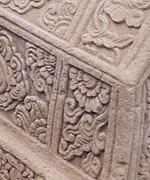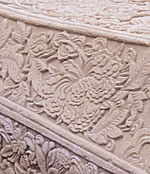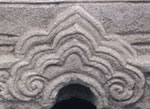| |
|
 |
|
 |
Cenotaph
China, Yuan dynasty (1271–1368), 14th century
Stone
Inner Mongolia Museum, Hohhot
cat. 205
[click images for full object view] |
 |
 |
 |
 |
 |
China, Yuan dynasty (1271–1368), 14th century
This cenotaph, or grave marker, which was found near the city of
Chifeng in Inner Mongolia [map],
demonstrates the presence of Muslims among the upper echelons of
Chinese society under the Yuan dynasty.
|
|
 |
 |
| Dramatic clouds and large peonies fill
the larger bands on the sides, vegetal scrolls with peonies and lotuses
are carved inside narrower bands below, and lotus or peony flowers
seen from above are shown in the vertical bands at both ends of the
cenotaph. The top is also decorated with dense vegetal patterns. |
|
 |
 |
The head of the cenotaph, below a lobed
arch with a lotus flower at its apex, is inscribed in slender Arabic
script with the Shahada, the Muslim profession of faith:
“There is no god but God (Allah). Muhammad is the messenger
of God (Allah).”
|
|
 |
 |
| The inscription was not carved in relief
like the rest of the decoration, suggesting that the cenotaph was
originally made for an unknown customer and subsequently customized
for a Muslim patron. |
|
 |
 |
 |
 |
 |
|
|
|


